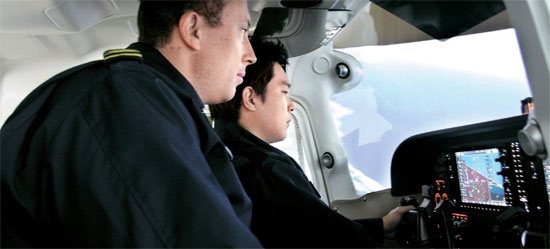Wild blue yonder lures bored, stressed workers

“Why would you leave a stable job?” they asked.
Lee’s reply: “Demand for aviators is constantly increasing and there’s a shortage of pilots, so there is promise [in becoming a pilot].”
What’s more, pilots make even better money than mainline corporate jobs - and they deal with less stress.
“After a flight, you can rest for several days,” Lee said. “Compared to working at a major corporation, there is much more personal time and aside from becoming a captain, there’s no stress about promotions.”
Many corporate salarymen like Lee are looking to the skies for new, better lives. Interest in aviation jobs among corporate employees in their 30s is taking off. And no wonder: Working hours for pilots are strictly limited (to prevent fatigue) and the starting salary of an airline pilot is 130 million won a year.
Starting in 2007, Lee attended the Korea Pilot School located at Gimpo International Airport and received a commercial pilot license (CPL). After he quit his job in 2010, he began to fly for a transportation company. After flying almost 1,000 hours, he became a co-pilot for Eastar Jet, a low-cost airline.
Choi Duk-su, 34, quit Daewoo Engineering and Construction after four years and went abroad to study aviation. Currently, he is training at the Westwind School of Aeronautics in Phoenix, Arizona, to fulfill his dream of becoming a pilot. “Although I was scared of change, after I evaluated my satisfaction with my job and my need for personal development, I thought it was worth challenging myself with something new,” he said.
“People in medical schools and law schools can’t find jobs,” said a representative of a pilot training school.
According to airline industry analysts, Korean Air and Asiana Airlines will bring in 50 and 30 new aircraft respectively by 2016 and hire 1,600 pilots. That means 400 new pilot positions will be opening up each year.
There are two methods for a civilian without Air Force training to become a pilot. The first is to obtain a CPL from a national pilot school. The second is to obtain one from abroad. Until several years ago, going abroad to study flying in the United States or Australia was the most common route.
But starting in July 2010, the Ministry of Land, Transport and Maritime Affairs, with the Korea Aerospace University and Hanseo University, established the Uljin Flight Training Center, which enabled people in Korea to train domestically. Besides Uljin, the Halla Sky Air Aviation and the Airline Pilots Association of Korea also operate training centers.
Westwind is a popular U.S. pilot training center for Koreans, and earlier this year there were 20 Koreans studying there. Between July and November, 30 more students joined them. Lee Dong-uk, dean at Westwind, said, “There are many company workers who have prepared for three to four months and came to study abroad.” Uljin Flight Training Center currently has 90 students and over half have come from established jobs in Korean companies. The training center expects by January to have over 70 students. Only 200 hours of training are given at the training at Uljin Flight Training Center, but 1,000 are needed to join a major airline.
By Jung Won-yeob [sarahkim@joongang.co.kr]










with the Korea JoongAng Daily
To write comments, please log in to one of the accounts.
Standards Board Policy (0/250자)